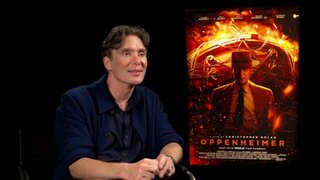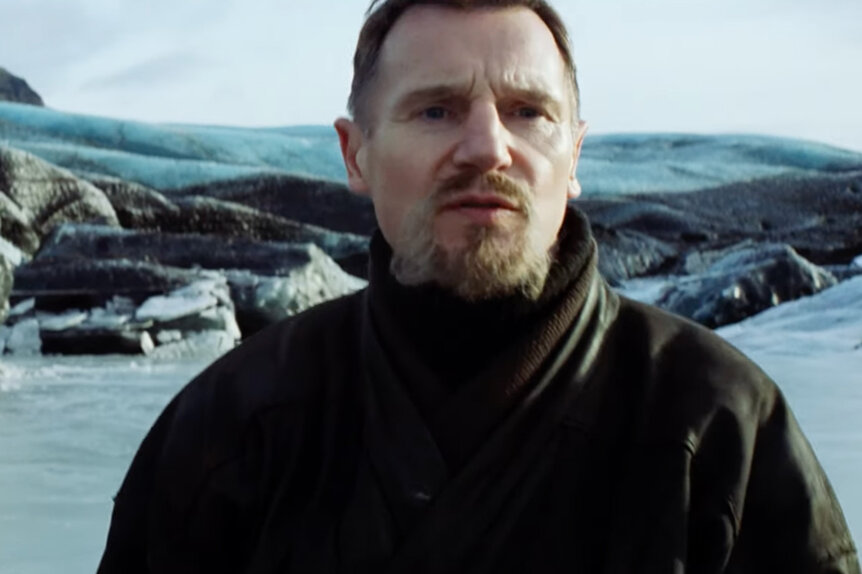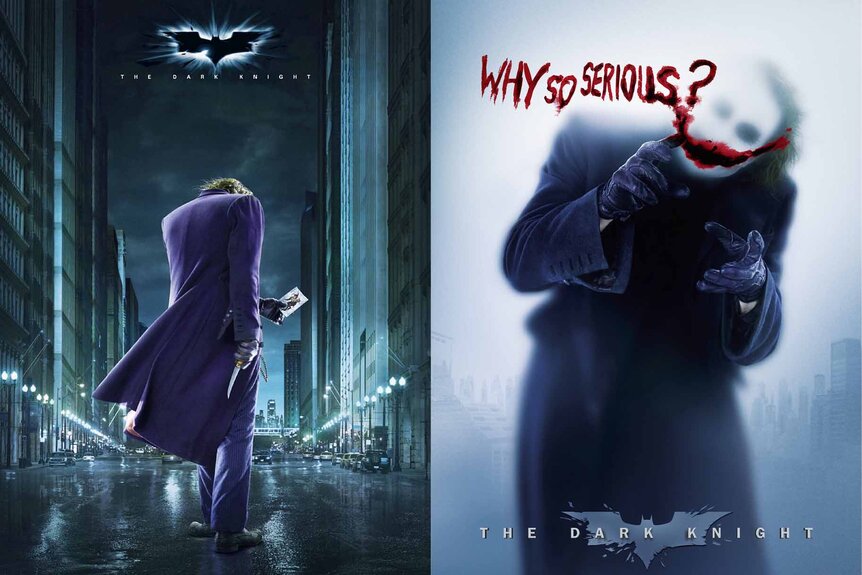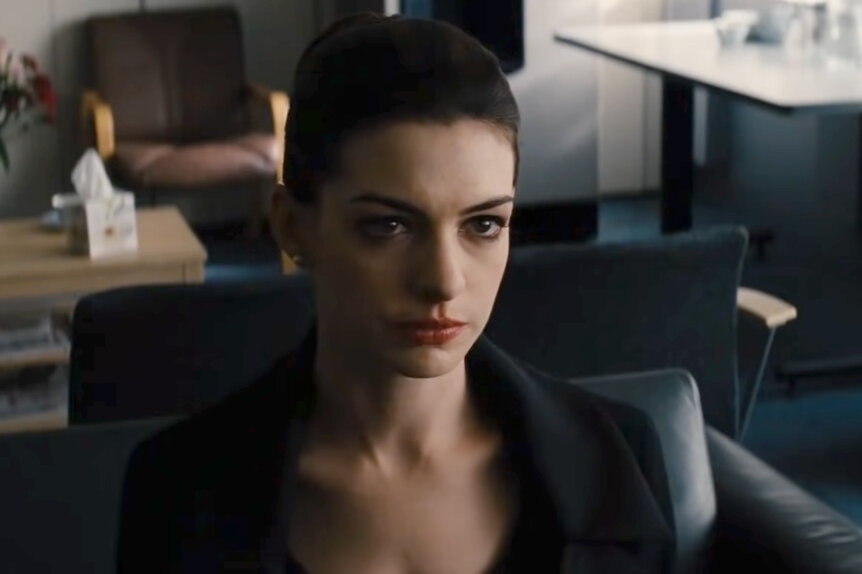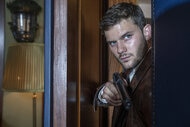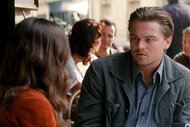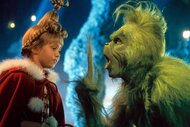Create a free profile to get unlimited access to exclusive videos, sweepstakes, and more!
How The Dark Knight Trilogy Chose Each of Its Iconic Villains
Christopher Nolan's Dark Knight trilogy is an interesting balance of the realistic and the epic, and that's true of the villains too.
Whenever a new superhero film comes out, after the initial enthusiasm for the superhero or heroes in question is done, the next topic comes along like clockwork: Who's the villain? The right Big Bad in a given movie helps to set the tone for the action to come, letting us know not just what kind of showdown we're going to see, but what kind of film is going to grow up around them. It's an important choice for any superhero storyteller, and it always felt especially important in Christopher Nolan's Dark Knight trilogy (all three films are currently streaming on Peacock).
Nolan's three films, beginning with Batman Begins in 2005, set a new tone for Batman in the movies, offering up a film that blended the heightened reality of comic book worlds with a dose of realism that grounded the Caped Crusader's adventures in his humanity and his physical limits. That tone was key, and it meant that villain choices were especially crucial, because whatever villain arrived in each film needed to match that blend of the heightened and the human. So, how did Nolan and his collaborators choose each villain? Let's take a closer look at how we got this particular big-screen rogues gallery.
For More on The Dark Knight Trilogy:
Your Ultimate Christopher Nolan Binge Guide
DC Creative Director Recalls Working With Heath Ledger on The Dark Knight Posters
Remembering Batman Begins and Its Top Tier Cast
How Christopher Nolan Picked Each Villain in The Dark Knight Trilogy
Batman Begins - The Scarecrow and Ra's al Ghul
Even before he becomes Batman, Bruce Wayne (Christian Bale) encounters his first major adversary in the Dark Knight trilogy with Ra's al Ghul, a mysterious and powerful leader of a group of assassins known as the League of Shadows. In his quest to become a warrior for Gotham City, Bruce ends up trained by the League of Shadows, and later learns that Ra's al Ghul himself (Liam Neeson) was secretly the man teaching him everything from swordcraft to the art of vanishing. It's a villain choice that had major ramifications not just for Batman Begins, but for the entire trilogy, and it began with a simple quest for Nolan and his co-writer David S. Goyer: Find a villain who hadn't showed up in live-action before.
"I told Chris that among the villains that hadn't been seen in features yet was one of my favorites - Ra's al Ghul," Goyer recalled in Jody Duncan Jesser and Janine Pourroy's book The Art and Making of The Dark Knight Trilogy. "Chris asked, 'Who's Ra's al Ghul?' And I said, 'Funny you should ask,' because we'd been talking about coming up with a villain who was older and could function as Bruce's mentor, and then go bad and be the villain."
So, Ra's became the puppet-master behind Batman's entire early career, launching a subplot that would continue all the way through The Dark Knight Rises. In Gotham City proper, though, Batman needed a different early nemesis to launch his adventures on the city streets. For that, Goyer and Nolan turned to the Scarecrow (Oppenheimer star Cillian Murphy), another villain who hadn't yet seen big-screen time at that point.
"He's a psychiatrist who is driven by the idea of manipulating people through fear, and we felt that had an interesting relationship to what Bruce Wayne was embarking on with the Batman persona," Nolan explained in The Art and Making book.
Of course, there was still one problem: Scarecrow's creepy burlap mask didn't fit into the realistic aesthetic Nolan was developing. He had to come up with a reason why the character would don his comic book look in the first place. Finally, Nolan and Goyer decided that the mask would feature a hidden respirator inside, and thus protect Scarecrow from his own fear gas.
The Dark Knight - The Joker and Two Face
The most famous villain of the Dark Knight trilogy was teased all the way back at the end of Batman Begins, as Jim Gordon (Gary Oldman) shows Batman a Joker card left by a new criminal rising up through Gotham's streets. That made The Joker the natural choice for the sequel, but according to Nolan, the tease wasn't meant at the time as a guarantee of a sequel.
"We wanted to suggest possibilities for how the story would continue, not because we knew we were going to make a sequel, but because that was the feeling we wanted the audience to leave the theater with," Nolan explained in The Art and Making. "The ending of Batman Begins was specifically aimed at spinning off that element of the mythology in the audience's mind so that they could imagine what the Joker would be in that world."
It wasn't until years later, after making The Prestige, that Nolan sat down again with Goyer to figure out exactly how The Joker might figure into a new Batman story. What they eventually decided on was the idea that The Joker would emerge as a challenge to Bruce Wayne's notion that he could someday stop being Batman, that his work in Gotham City would be over in just a few years and he could go on and live a normal life.
"With the reveal of the Joker card at the end of Batman Begins, we created the sense that it wasn't going to be as simple as Bruce doing what he could for five years and then getting out," Nolan continued. "And then, in The Dark Knight, we would see Bruce getting deeper and deeper into his role as Batman. Batman's extraordinary response to crime would evoke a similar response from the criminal world. In a way, Batman himself would raise the extremity of behavior in Gotham, and would give rise to the Joker."
The extremity of Batman's behavior gave rise to another key idea in The Dark Knight: That the true heroic figure of the piece wouldn't be Bruce Wayne, but would instead be district attorney Harvey Dent (Aaron Eckhart), a principled and determined warrior for justice who wanted to clean up Gotham the legal, transparent way. With Dent, Nolan and Goyer saw a tragic hero who could end the middle chapter of their trilogy on a dark note with his transformation into another of Batman's most prominent foes: Two-Face.
"Bruce Wayne was the protagonist of the first film, but we decided early on that he would not be the protagonist of the second film - that, in fact, Harvey Dent would be," Goyer said in The Art and Making. "The character that changes [in the story] is Harvey Dent. He goes from being a White Knight to a horrifically scarred and tragic figure."
With Heath Ledger's Joker, The Dark Knight changed the face of Nolan's Gotham City forever, creating a more extreme version of the semi-realistic world of Batman Begins. And things were about to get even bigger and bolder.
The Dark Knight Rises - Bane and Catwoman
As The Dark Knight Rises begins, Bruce Wayne has essentially retired as Batman after the death of Harvey Dent. Years pass, and crime in Gotham seems to be under control under Commissioner Gordon's leadership. But darkness is brewing beneath the veneer of safety, and in order to illustrate that, co-writer Jonathan Nolan suggested to his brother Christopher, and to Goyer, that a new villain could quite literally rise up from beneath the city.
But which villain? Eventually, the Nolan brothers and Goyer decided upon Bane (eventually played by Tom Hardy), not an obvious choice due to his over-the-top nature in the comics, but the right one due to both the sheer physical threat he presented, and how different he was to The Joker.
"We'd never had a physical monster as our villain," Christopher Nolan said in The Art and Making. "Bane is a very well-conceived, physical villain in the comics, but someone who has an incredible mind as well. And whereas the Joker's backstory was very obscure, Bane's is epic. We wanted to go the opposite way this time, using a villain with a very rich origin story."
The secondary villain for the film, really more of an antihero and eventual hero, was Selina Kyle, aka Catwoman (Anne Hathaway), another villain who might not feel like a natural fit in the world of Nolan's films. But Jonathan Nolan campaigned for the character's inclusion as part of the larger three-film arc of the trilogy.
"It seemed to me that if we were trying to create a complete arc for Batman, we couldn't do it without Catwoman, and without that relationship between Catwoman and Batman," Jonathan Nolan said in The Art and Making.
Goyer added, "We kept thinking about Eartha Kitt in the role, which was not of the Christopher Nolan Batman universe at all. But we talked it through and found a way into the character that we thought was interesting. We still had questions about how were going to justify her catsuit, but Chris just pushed that question aside until later."
So, The Dark Knight Trilogy was complete, with six key villains and a host of other memorable characters along for the ride.
Catch Batman Begins, The Dark Knight, and The Dark Knight Rises, all streaming now on Peacock!
